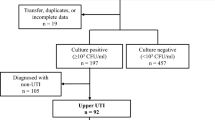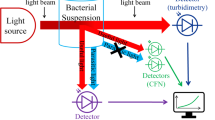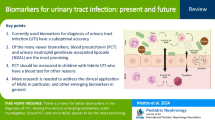Summary
Endotoxin is a component of the outer membrane of gram-negative rods (GNR). Since GNR are responsible for the majority of urinary tract infection (UTI), we measured the concentration of endotoxin in urine using chromogenic endotoxin-specific assay and examined its diagnostic utility in patients with suspected UTI. In all 18 urine samples with an endotoxin concentration exceeding 350 pg/ml and 2 samples with 10–350 pg/ml of endotoxin concentration, GNR were detected at a count of 104 cfu/ml. Negative for endotoxin were 3 samples of culture positive for grampositive cocci (GPC), 2 samples containing various bacterial contaminants and all 37 samples with no growth on culture. Two urine samples collected 5 h after antibiotic dosage showed negative culture for GNR but a significant concentration of endotoxin. In an in vitro experiment, a residual concentration of antibiotic in urine inhibited bacterial growth, leading to a falsenegative culture. These results suggest that chromogenic endotoxin assay is a reliable method for diagnosing UTI caused by GNR and detecting false-negative culture of GNR.
Similar content being viewed by others
References
Levin J, Bang FB (1964) The role of endotoxin in the extracellular coagulation of limulus blood. Bull Johns Hopkins Hosp 115: 265
Nachum R, Berzofsky RN (1985) Chromogenic limulus amoebocyte lysate assay for rapid detection of gram-negative bacteriuria. J Clin Microbiol 21: 759
Nurminen M, Karvonen M, Siitonen A (1988) Detection of gram-negative bacteria in urine by the chromogenic limulus assay. Eur J Clin Microbiol Infect Dis 7: 529
Obayashi T, Tamura H, Tanaka S, Ohki H, Takahashi S, Arai M, Masuda M, Kawai T (1985) A new chromogenic endotoxin-specific assay using recombined limulus coagulation enzymes and its clinical applications. Clin Chem Acta 149: 55
Pearson FC, Dubozak J, Weary M, Bruszer G, Donohne (1985) Detection of endotoxin in the plasma of patients with gramnegative bacterial sepsis by the limulus amoebocyte lysate assay. J Clin Microbiol 21: 865
Sawbolle M, Jorgensen J (1987) Use of the limulus amebocyte lysate test as a cost-effective screen for gram-negative agents of meningitis. Diag Microbiol Infect Dis 7: 177
Author information
Authors and Affiliations
Rights and permissions
About this article
Cite this article
Matsumoto, T., Tanaka, M., Ogata, N. et al. Significance of urinary endotoxin concentration in patients with urinary tract infection. Urol. Res. 19, 293–295 (1991). https://doi.org/10.1007/BF00299061
Accepted:
Issue Date:
DOI: https://doi.org/10.1007/BF00299061




